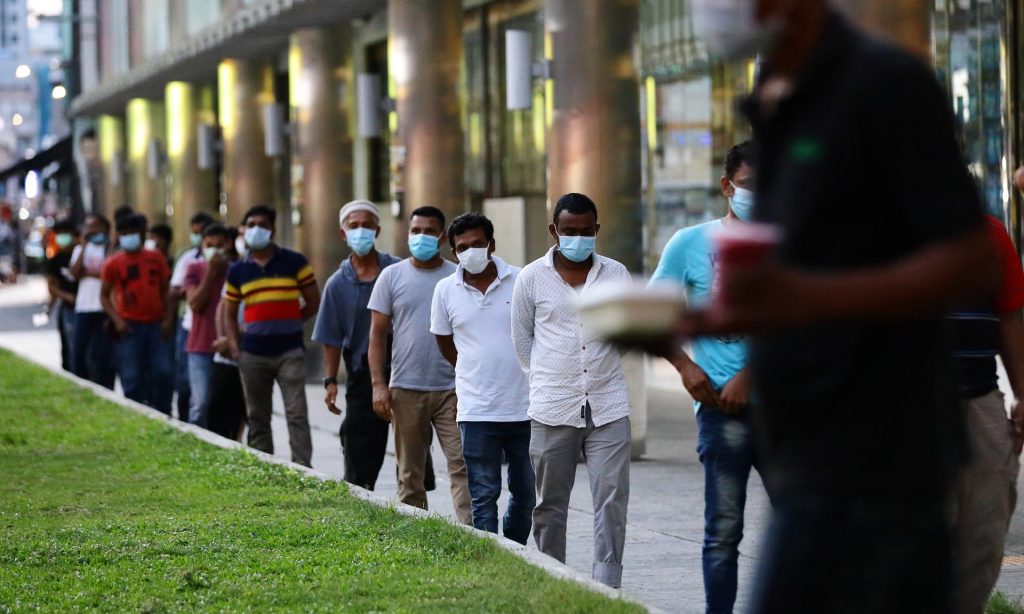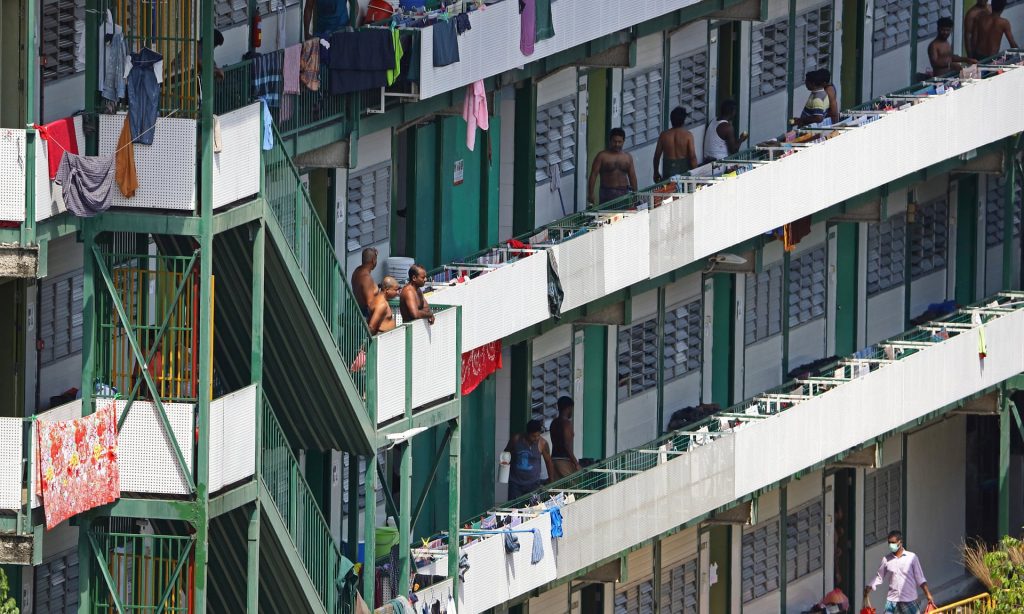City-state has been lauded for its comprehensive measures but officials have been accused of overlooking key group

Foreign workers wearing protective masks queue for free meals in Singapore Photograph: Suhaimi Abdullah/Getty Images
Singapore, praised for its gold standard approach to tracing coronavirus cases, is facing a surge in transmission linked to its cramped migrant workers’ dormitories, where thousands more infections are expected to emerge.
The health ministry reported 728 new cases on Thursday, the biggest rise in a single day, as medical teams raced to test and isolate workers living in vast dormitory blocks.
While Singapore has been lauded for its rapid and comprehensive approach to contract tracing, officials have been accused of overlooking the dormitories, where thousands of workers live in close quarters and between 12 and 20 men might share a single room.
In March the campaign group Transient Workers Count Too (TWC2) urged officials to make plans to protect workers, warning: “The risk of a new cluster among this group remains undeniable.” Authorities are resorting to moving men to multi-storey car parks, military camps and floating hotels in an attempt to reduce crowding.
Mohan Dutta, a professor at Massey University in New Zealand, who has interviewed 45 migrant workers in Singapore since the outbreak began, said many feared an outbreak was inevitable due to the conditions.
“Participants told me that even up until Monday they don’t have access to soap and adequate cleaning supplies,” he said. While migrants were being served food so that they did not use shared kitchens, the quality of meals was poor and lacking in nutrition. In some cases 100 men were sharing five toilets and five showers.
Nine dormitories, the biggest of which holds 24,000 men, have been declared isolation units by officials, while all other buildings accommodating the city-state’s 300,000 workers have been placed under effective lockdown. The restrictions, an attempt to reduce further transmission, have left the dormitories even more crowded than usual as only essential workers are permitted to leave.
One construction worker, from Bangladesh, told the Guardian there were long queues to use shared bathrooms which often did not have enough water for the showers or toilets to function.
No one in his dormitory had yet tested positive, he said, but some people had temperatures of 38C. “In my room and other rooms also there are many [with] symptoms, some feel [they have] no energy, someone has body aches,” he said. “We are frightened.”

The government said it had increased cleaning services in the dormitories, which are usually privately operated, and was providing meals to workers and moving people to alternative accommodation.Advertisement
Professor Dale Fisher, a senior consultant in infectious diseases at Singapore’s National University Hospital, said medical teams had moved from hospitals to test people on site quickly. “If we don’t stop it there the hospitals will get overwhelmed.”
It was likely that thousands more cases would be discovered, Fisher said. “[The men] are all 30 to 40 years old, which is good, but still when you’re dealing with these massive numbers you’re going to get a good number of sick 30 to 40-year-olds.
“The risk [relating to migrant worker dormitories] is completely different and the preparation and the anticipation wasn’t there.
“The message to other places is, if you have an overcrowded setting it is just so vulnerable,” Fisher said, pointing to slum areas in countries such as India. “When people say India’s shutdown has been extended – I can’t think of anything other than shutting down. It’s like the only defence you’ve got.”
The second wave of cases in Singapore has brought the total number of infections to 4,427 including 10 deaths. Fisher said he was not aware of any fatalities among migrant worker clusters but these typically were not recorded until a later date.
Singapore’s migrant workers, who are largely from India and Bangladesh, are an essential part of the work force. Many toil for long hours on the country’s construction sites, building its skyscrapers and shopping malls, so that they can send money to relatives back home.
It is not uncommon for workers, who have temporary contracts and are dependent upon their employers for work permits, to be paid less than promised. Workers might be promised as much as S$1,200 per month, but typically receive anything between S$500-750, according to Dutta. The workers pay large sums in agency fees to work in Singapore and are often reluctant to complain for fear of being deported.
Workers’ dormitories are on the outskirts of the city-state, which, Dutta said, “makes them in many ways invisible to the landscape of Singapore”.
Article Source
